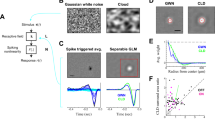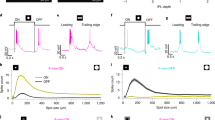Abstract
THE ganglion cells of the frog retina can be sub-divided into different functional classes1. When investigated under light adapted conditions, class I cells (sustained edge detectors) respond to sharp edges moving through their receptive field, giving a stronger response when the object causing the edge is small than when it is large. A sustained response occurs when an edge is stopped within the field. In darkness, with a standing edge present in the receptive field, a response can be elicited by turning on the light or by a short flash of light.
This is a preview of subscription content, access via your institution
Access options
Subscribe to this journal
Receive 51 print issues and online access
$199.00 per year
only $3.90 per issue
Buy this article
- Purchase on Springer Link
- Instant access to full article PDF
Prices may be subject to local taxes which are calculated during checkout
Similar content being viewed by others
References
Maturana, H. R., Lettvin, J. Y., McCulloch, W. S., and Pitts, W. H., J. Gen. Physiol., 43, 129 (1960).
Grüsser, O.-J., Grüsser-Cornehls, U., and Bullock, Th. H., Pflügers Arch. ges. Physiol., 279, 88 (1964).
Schipperheyn, J. J., Acta Physiol. Pharmacol. Neerl., 13, 231 (1965).
Author information
Authors and Affiliations
Rights and permissions
About this article
Cite this article
PICKERING, S., VARJÚ, D. Ganglion Cells in the Frog Retina: Inhibitory Receptive Field and Long-latency Response. Nature 215, 545–546 (1967). https://doi.org/10.1038/215545a0
Received:
Published:
Issue Date:
DOI: https://doi.org/10.1038/215545a0
This article is cited by
-
A model of anuran retina relating interneurons to ganglion cell responses
Biological Cybernetics (1991)
-
Responses of receptive fields of frog retinal ganglion cells to the leading and trailing edges of moving stimuli
Neurophysiology (1980)
-
The retinal ON-OFF components giving rise to the delayed response
Kybernetik (1971)
-
Delayed responses of ganglion cells in the frog retina: the influence of stimulus parameters upon the discharge pattern
Kybernetik (1969)
Comments
By submitting a comment you agree to abide by our Terms and Community Guidelines. If you find something abusive or that does not comply with our terms or guidelines please flag it as inappropriate.



